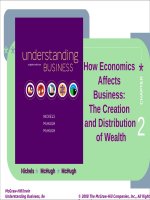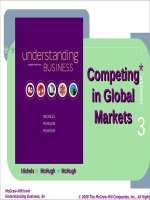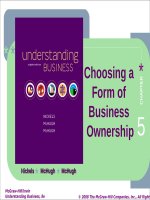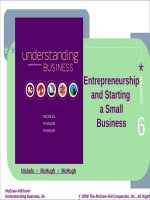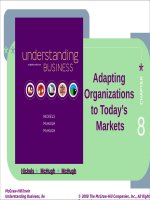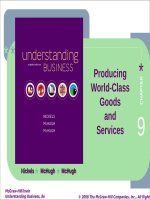Understanding business 11th by mchugh nickels chap002
Bạn đang xem bản rút gọn của tài liệu. Xem và tải ngay bản đầy đủ của tài liệu tại đây (1.44 MB, 58 trang )
CHAPTER 2
Understandin
g Economics
and
How it Affects
Business
McGraw-Hill/Irwin
Copyright © 2015 by the McGraw-Hill Companies, Inc. All rights reserved.
LEARNING OBJECTIVES
1. Explain basic economics.
2. Explain what capitalism is and how free markets
work.
3. Compare socialism and communism.
1-2
LEARNING OBJECTIVES
4. Analyze the trend toward mixed economies.
5. Describe the economic system of the U.S., including
the significance of key economic indicators
(especially GDP), productivity and the business
cycle.
6. Contrast fiscal policy and monetary policy, and
explain how each affects the economy.
1-3
MATT FLANNERY
Kiva
• Co-founder of Kiva.org and
helps people in developing
countries get small loans.
• Microlending has been a
source of funding in the
developing world since the
1980s.
• Came up with the idea while
working in rural Africa.
2-4
NAME that COMPANY
This organization has administrative control over
the Florida Power and Light Company because
the United States wants to control potential
monopolies.
Name that organization!
1-5
The MAJOR BRANCHES of
ECONOMICS
LO 2-1
• Economics -- The study of how society employs
resources to produce goods and services for
consumption among various groups and
individuals.
• Macroeconomics -- Concentrates on the operation
of a nation’s economy as a whole.
• Microeconomics -- Concentrates on the behavior
of people and organizations in markets for particular
products or services.
2-6
RESOURCE DEVELOPMENT
LO 2-1
• Resource
Development -- The
study of how to
increase resources and
create conditions that
will make better use of
them.
2-7
EXAMPLES of WAYS to
INCREASE RESOURCES
LO 2-1
• New energy sources
– Hydrogen fuel
• New ways of growing
foods
– Hydroponics
• New ways of creating
goods and services
– Aquaculture
– Nanotechnology
2-8
THOMAS MALTHUS and
the DISMAL SCIENCE
LO 2-1
• Malthus believed that if the rich had most of
the wealth and the poor had most of the
population, resources would run out.
• This belief led the writer Thomas Carlyle to
call economics “The Dismal Science.”
• Neo-Malthusians believe there are too many
people in the world and believe the answer is
radical birth control.
2-9
POPULATION as a RESOURCE
LO 2-1
• Contrary to Malthus, some
economists believe a large
population can be a
resource.
- An educated population is
highly valuable.
- Business owners provide
jobs and economic growth for
their employees and
communities as well as for
themselves.
2-10
ADAM SMITH the
FATHER of ECONOMICS
LO 2-1
Smith believed that:
• Freedom was vital to any
economy’s survival.
• Freedom to own land or
property and the right to
keep the profits of a
business is essential.
• People will work hard if
they believe they will be
rewarded.
2-11
The INVISIBLE HAND THEORY
LO 2-1
• As people improve their own situation in life,
they help the economy prosper through the
production of goods, services and ideas.
• Invisible Hand -- When self-directed gain leads to
social and economic benefits for the whole
community.
2-12
UNDERSTANDING the
INVISIBLE HAND THEORY
LO 2-1
• A farmer earns money by selling
his crops.
• To earn more, the farmer hires
farmhands to produce more
crops.
• When the farmer produces more,
there is plenty of food for the
community.
• The farmer helped his
employees and his community
while helping himself.
2-13
HOW CORRUPTION HARMS
the ECONOMY
• In many countries, a businessperson must
bribe the government to gain permission to
own land, build, and conduct business
operations.
Imagine you are a restaurant owner in need of a
liquor license, but have been unable to get one.
You know people in government. Would you be
tempted to make large contributions to their reelection campaign to receive that license?
2-14
TEST PREP
• What is the difference between macroeconomics
and microeconomics?
• What is better for an economy than teaching a
man to fish?
• What does Adam Smith’s term invisible hand
mean? How does the invisible hand create wealth
for a country?
2-15
CAPITALISM
LO 2-2
• Capitalism -- All or most of the land, factories
and stores are owned by individuals, not the
government, and operated for profit.
• Countries with capitalist
foundations:
- United States
- England
- Australia
- Canada
2-16
STATE CAPITALISM
LO 2-2
• State Capitalism -- When the state, rather than
private owners, run some businesses.
• Well-known countries practicing state
capitalism:
- China
- Russia
• These countries have experienced some success
using capitalistic principles, but the future is still
uncertain.
2-17
CAPITALISM’S
FOUR BASIC RIGHTS
LO 2-2
1. The right to own private
property.
2. The right to own a business
and keep all that business’s
profits.
3. The right to freedom of
competition.
4. The right to freedom of choice.
2-18
ROOSEVELT’S FOUR
ADDITIONAL RIGHTS
LO 2-2
1. Freedom of speech and
expression.
2. Freedom to worship in your
own way.
3. Freedom from want.
4. Freedom from fear.
2-19
FREE MARKETS
LO 2-2
• Free Market -- Decisions about what and how
much to produce are made by the market.
• Consumers send signals about what they like
and how they like it.
• Price tells companies how much of a product
they should produce.
• If something is wanted but hard to get, the
price will rise until more products are
available.
2-20
CIRCULAR FLOW MODEL
LO 2-2
2-21
PRICING
LO 2-2
• A seller may want to sell
shirts for $50, but only a
few people may buy them
at that price.
• If the seller lowers the price
to $30, more people buy
the shirts.
• The seller establishes a
price of $30 based on what
consumers are willing to
pay.
2-22
SUPPLY CURVES
LO 2-2
• Supply -- The quantities of products businesses
are willing to sell at different prices.
2-23
DEMAND CURVES
LO 2-2
• Demand -- The quantities of products consumers
are willing to buy at different prices.
2-24
EQUILIBRIUM
LO 2-2
• Market Price (Equilibrium Point) -- Determined
by supply and demand, this is the negotiated
price.
2-25

